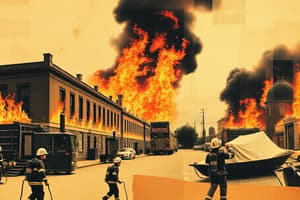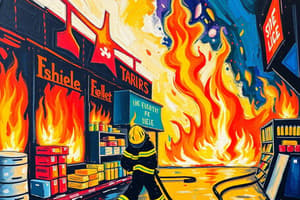Podcast
Questions and Answers
What is a key difference in fire tactics between commercial and residential fires?
What is a key difference in fire tactics between commercial and residential fires?
- Fire attacks in residential fires should be more aggressive.
- Residential fires require more extensive water supply.
- Flow rates used in residential fires are also applicable in commercial fires.
- Commercial fires necessitate higher target flow rates. (correct)
Why might search operations be less effective in commercial buildings compared to residential structures?
Why might search operations be less effective in commercial buildings compared to residential structures?
- Commercial fires are often located in confined areas.
- The complexity and size of commercial spaces can hinder search operations. (correct)
- Firefighters are less familiar with commercial buildings.
- Commercial buildings have a greater number of firefighters available.
What is the optimal moment to extinguish a commercial fire?
What is the optimal moment to extinguish a commercial fire?
- As soon as the fire is reported.
- At its smallest state after arrival. (correct)
- Once the fire has been fully developed.
- When enough firefighting personnel is on scene.
What is the primary focus for fire resources in commercial fire scenarios?
What is the primary focus for fire resources in commercial fire scenarios?
How do building fire suppression systems play a role in commercial fire control?
How do building fire suppression systems play a role in commercial fire control?
What distinguishes the life safety potential between commercial and residential fires?
What distinguishes the life safety potential between commercial and residential fires?
What aspect should be prioritized in the risk management plan during a commercial fire?
What aspect should be prioritized in the risk management plan during a commercial fire?
What challenge do commercial buildings present in terms of fire loads?
What challenge do commercial buildings present in terms of fire loads?
What is the minimum volume for water application when using large volume handlines in an offensive strategy?
What is the minimum volume for water application when using large volume handlines in an offensive strategy?
Which NFPA standard specifies the minimum number of handlines required for fire control?
Which NFPA standard specifies the minimum number of handlines required for fire control?
What is a key factor in transitioning from an offensive to a defensive fire suppression strategy?
What is a key factor in transitioning from an offensive to a defensive fire suppression strategy?
In the context of fire control, what is considered a significant challenge for ventilation in commercial buildings?
In the context of fire control, what is considered a significant challenge for ventilation in commercial buildings?
What role do Company Officers and Sector Officers play in fire attack operations?
What role do Company Officers and Sector Officers play in fire attack operations?
Which method is suggested for water application to improve conditions prior to entry?
Which method is suggested for water application to improve conditions prior to entry?
What is a crucial aspect to consider regarding ventilation openings in commercial buildings?
What is a crucial aspect to consider regarding ventilation openings in commercial buildings?
Why might vertical ventilation pose a greater challenge in commercial fires compared to horizontal ventilation?
Why might vertical ventilation pose a greater challenge in commercial fires compared to horizontal ventilation?
What factor significantly affects the life safety potential during commercial fires?
What factor significantly affects the life safety potential during commercial fires?
Which tactic is most critical for effectively managing a commercial fire in its initial stages?
Which tactic is most critical for effectively managing a commercial fire in its initial stages?
Why is it essential to understand fire behavior in the context of commercial fires?
Why is it essential to understand fire behavior in the context of commercial fires?
What aspect makes search operations particularly dangerous in commercial fires?
What aspect makes search operations particularly dangerous in commercial fires?
What should be the priority for resources during a commercial fire response?
What should be the priority for resources during a commercial fire response?
What is a major disadvantage of a commercial building's structure compared to residential buildings in a fire scenario?
What is a major disadvantage of a commercial building's structure compared to residential buildings in a fire scenario?
When responding to a commercial fire, what type of ventilation strategy may pose additional challenges?
When responding to a commercial fire, what type of ventilation strategy may pose additional challenges?
Which condition is critical for a successful fire attack in commercial structures?
Which condition is critical for a successful fire attack in commercial structures?
What is the primary role of Sector Officers and the Incident Commander (IC) in the context of rescue operations during a fire?
What is the primary role of Sector Officers and the Incident Commander (IC) in the context of rescue operations during a fire?
When conditions do not allow safe interior fire suppression, what strategy should be employed?
When conditions do not allow safe interior fire suppression, what strategy should be employed?
Which of the following factors is the most significant challenge for effective ventilation in commercial fires?
Which of the following factors is the most significant challenge for effective ventilation in commercial fires?
What should Company Officers focus on when determining fire attack strategies for a commercial fire?
What should Company Officers focus on when determining fire attack strategies for a commercial fire?
Why is it important to coordinate ventilation with fire attack operations?
Why is it important to coordinate ventilation with fire attack operations?
What is a common misconception about the effectiveness of vertical ventilation in commercial fires?
What is a common misconception about the effectiveness of vertical ventilation in commercial fires?
What minimum volume of water is typically recommended for large volume handlines in offensive fire tactics?
What minimum volume of water is typically recommended for large volume handlines in offensive fire tactics?
What is the NFPA 1710 standard regarding the use of handlines in fire control operations?
What is the NFPA 1710 standard regarding the use of handlines in fire control operations?
Flashcards are hidden until you start studying
Study Notes
Definition and Characteristics of Commercial Buildings
- Commercial buildings include structures used for business, manufacturing, and storage, primarily non-residential.
- These buildings vary in size and complexity, being able to stand alone or be part of other occupancies, often multi-story and below grade.
- They typically contain large volumes of contents, including hazardous materials, and have less compartmentalization than residential buildings.
Firefighting Strategy Differences
- Residential fire tactics are not effective for commercial fires; minimum flow rates should follow NFPA 1710 standards.
- Large open spaces in commercial buildings complicate search operations due to fire and smoke conditions; residential areas allow for more effective searches.
- Quick fire extinguishment is vital to ensure victim safety, especially in known rescue scenarios.
Fire Behavior and Conditions
- Commercial fires are more complex due to large areas and heavy content loads, producing severe fire conditions.
- Early fire attack when the fire is at its smallest state is critical for success.
- Supporting existing building fire suppression systems enhances control of fire situations.
Water Volume and Application
- Large volume handlines (minimum 250 GPM) are necessary for effective fire attack.
- NFPA 1710 mandates at least three handlines with a collective flow of 500 GPM or more.
- Application can be executed from either interior or exterior positions depending on fire conditions.
Tactical Considerations
- In offensive strategies, Company Officers should use adequate water flow to combat the fire.
- If conditions are unsafe for interior suppression, switch to a defensive strategy, utilizing exterior water application when necessary.
- The strategy employed must be responsive to changing conditions, emphasizing water volume to overcome fire intensity.
Ventilation Challenges and Techniques
- Effective ventilation in commercial buildings requires careful planning, taking into account building size and natural openings.
- Horizontal or vertical ventilation strategies should be coordinated with fire attacks for better effectiveness.
- Vertical ventilation can be challenging; adequate exhaust openings may be difficult to achieve due to building volume.
Coordination and Communication
- Incident Commanders (IC) must work with Sector Officers for effective ventilation and fire control.
- Preventing rapid fire growth is crucial while fire companies operate inside the building, necessitating constant communication and reassessment of conditions.
Definition and Characteristics of Commercial Buildings
- Commercial buildings include structures used for business, manufacturing, and storage, primarily non-residential.
- These buildings vary in size and complexity, being able to stand alone or be part of other occupancies, often multi-story and below grade.
- They typically contain large volumes of contents, including hazardous materials, and have less compartmentalization than residential buildings.
Firefighting Strategy Differences
- Residential fire tactics are not effective for commercial fires; minimum flow rates should follow NFPA 1710 standards.
- Large open spaces in commercial buildings complicate search operations due to fire and smoke conditions; residential areas allow for more effective searches.
- Quick fire extinguishment is vital to ensure victim safety, especially in known rescue scenarios.
Fire Behavior and Conditions
- Commercial fires are more complex due to large areas and heavy content loads, producing severe fire conditions.
- Early fire attack when the fire is at its smallest state is critical for success.
- Supporting existing building fire suppression systems enhances control of fire situations.
Water Volume and Application
- Large volume handlines (minimum 250 GPM) are necessary for effective fire attack.
- NFPA 1710 mandates at least three handlines with a collective flow of 500 GPM or more.
- Application can be executed from either interior or exterior positions depending on fire conditions.
Tactical Considerations
- In offensive strategies, Company Officers should use adequate water flow to combat the fire.
- If conditions are unsafe for interior suppression, switch to a defensive strategy, utilizing exterior water application when necessary.
- The strategy employed must be responsive to changing conditions, emphasizing water volume to overcome fire intensity.
Ventilation Challenges and Techniques
- Effective ventilation in commercial buildings requires careful planning, taking into account building size and natural openings.
- Horizontal or vertical ventilation strategies should be coordinated with fire attacks for better effectiveness.
- Vertical ventilation can be challenging; adequate exhaust openings may be difficult to achieve due to building volume.
Coordination and Communication
- Incident Commanders (IC) must work with Sector Officers for effective ventilation and fire control.
- Preventing rapid fire growth is crucial while fire companies operate inside the building, necessitating constant communication and reassessment of conditions.
Studying That Suits You
Use AI to generate personalized quizzes and flashcards to suit your learning preferences.




